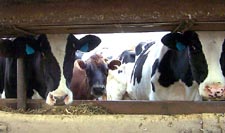Plan Now for Dairy Winter Feed Needs
Plan Now for Dairy Winter Feed Needs

Published on September 26, 2002
Plan now for feeding your dairy herd for the upcoming months is the message from University of Kentucky Extension Dairy Nutrition Specialist, Donna Amaral-Phillips.
Due to some rough weather conditions for forage production in parts of the state, farmers need to make the very best use of forages on hand.
"Farmers need to plan now how they are going to use their forage supplies and whether they will need to make adjustments in cattle numbers or purchase additional feed to make it until next spring," Amaral-Phillips said.
Amaral-Phillips advises dairy farmers to first determine the amount of forages needed for the number and type of dairy cattle to be fed. Compare the amount of forages on hand to the amount needed to identify any shortages.
UK Cooperative Extension offices can provide materials to guide farmers through the process of calculating forage needs for their individual operations.
To avoid running out of feed this winter or early spring, forage purchases may be necessary.
"If you want to purchase hay, you need to do so in the near future. Locally produced hay is scarce this year and western hay production is also down," Amaral-Phillips cautioned.
Other options that may be more economical, according to Amaral-Phillips, include feeding additional commodities such as corn gluten feed or soyhulls. Farmers are encouraged to check with an animal nutritionist to see what will work for their operation.
If commodities are going to be used, begin feeding a few pounds of the commodity throughout the winter-feeding season to keep a consistent ration.
"Feeding commodities across the entire winter feeding season can also spread the costs of this feed over many months versus high feed costs over a month or two. In the long term this can help cash flow," Amaral-Phillips said.
Testing the forages on hand is the next critical step in good feed planning. By testing forages, farmers can meet the nutritional needs of their cattle by allocating the best forages where they can have the greatest impact on performance.
For instance, shortly after calving, cattle cannot eat as much feed as they can later. Therefore, they need the best quality of forages.
Time spent planning now can help avoid shortages later this winter or early spring when feed costs will be the highest.
